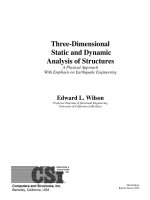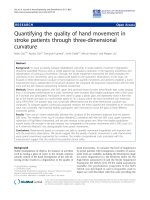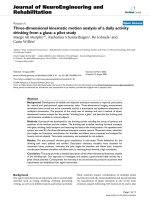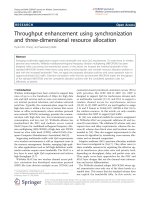Three Dimensional Integration and Modeling A Revolution in RF and Wireless Packaging by Jong Hoon Lee Emmanuil Manos M Tentzeris and Constantine A Balanis_7 ppt
Bạn đang xem bản rút gọn của tài liệu. Xem và tải ngay bản đầy đủ của tài liệu tại đây (832.33 KB, 12 trang )
CAVITY-TYPE INTEGRATED PASSIVES 63
TABLE 5.3: Total phase shifts for two different paths in the dual-mode cavity filter.
PATHS BELOW RESONANCE ABOVE RESONANCE
Port 1-1-2-port 2 −90
◦
+ 90
◦
+ 90
◦
+ 90
◦
−90
◦
=+90
◦
−90
◦
−90
◦
+ 90
◦
−90
◦
−90
◦
=−270
◦
Port 1-port 2 −90
◦
−90
◦
Result Out of phase Out of phase
more than the lower transmission zeros because of the asymmetrical effect of M upon the upper
and lower poles [67]. The centerline offset, C
o,
affects the performance of the 3-dB bandwidth and
center frequency as well. It is observed that the maximum 3-dB bandwidth is obtained at the offset
of 0.2 mm with the maximum coupling between dual modes.
Further increase of the offset results in a narrower bandwidth because the level of coupling
for TE
102
and TE
201
changes. The downward shifting of the center frequency could be caused by
the difference between the mean frequency ((f
o
+ f
e
)/2) and the original resonant frequency of the
cavity resonator. Also, external coupling can be attributed to the center frequency shift because of
additional parasitic reactance from the feeding structures.
55 60 65 70 75
-70
-60
-50
-40
-30
-20
-10
0
S21 (dB)
Frequency (GHz)
C
O
(mm)
0
0.2
0.4
0.6
FIGURE 5.18: Simulated S21 parameter response of a dual mode filter as a function of the centerline
offset C
o
of the feeding structures.
64 THREE-DIMENSIONAL INTEGRATION
52 54 56 58 60 62 64 66
-70
-60
-50
-40
-30
-20
-10
0
dB
Frequency (GHz)
D
S
(mm)
1.47
1.37
1.27
1.17
FIGURE5.19: Simulated S21parameterresponseofa dual modefilter as afunction of thesource-to-load
distance D
s
.
The transmission characteristic of the filter has also been investigated with respect to the
values of L
c
by varying the distance D
s
between two external slots with a fixed centerline offset,
C
o
. Figure 5.19 displays the simulated response of a dual mode filter as a function of D
s
with
C
o
= 0.5 mm. As L
c
decreases by increasing D
s
, the lower transmission zero shifts away from the
center frequency while the higher transmission zero moves toward to the center frequency. The
cross coupling, L
c
, causes the asymmetrical shift of both transmission zeros due to the same reason
mentioned in the case of M, influencing the lower transmission zero more than the higher one. The
equivalent-circuit models validate the coupling mechanisms through the design of a transmitter filter
in the next subsection.
5.4.1.5 Quasi-elliptic Dual-Mode Cavity Filter. Two dual-mode cavity filters exhibiting a quasiel-
liptical response are presented as the next step for a three-dimensional integrated V-band transceiver
front-end modules. The frequency range of interest is divided into two channels where the lower
channel is allocated for an Rx, and the higher channel allocated for a Tx. To suppress the interfer-
ence between the two channels as much as possible, the upper stop-band transmission zero of the
Rx channel is placed closer to the center frequency of the passband than the lower stop-band zero.
In the case of a Tx filter, the lower zero is located closer to the center frequency of the passband than
the upper zero.
CAVITY-TYPE INTEGRATED PASSIVES 65
54 56 58 60 62 64 66
-70
-60
-50
-40
-30
-20
-10
0
dB
Frequency (GHz)
S21 (measured)
S21 (simulated)
S11 (measured)
S11 (simulated)
FIGURE 5.20: Measured and simulated S-parameters of the dual-mode c avity filter for an Rx channel.
First, a Rx filter was designed and validated with experimental data, as shown in Fig. 5.20. A
line-reflect-reflect-match (LRRM) method [86] was employed for calibration of the measurements
with 250m pitch air coplanar probes. In the measurement, the reference planes were placed at
the end of the probing pads, and the capacitance and inductance effects of the probing pads were
de-embedded by use of “Wincal” software so that effects, such as those due to the CPW loading,
become negligible. The filter exhibits an insertion loss of <2.76 dB, center frequency of 61.6 GHz,
and 3-dB bandwidth of about 4.13% (≈2.5 GHz). The upper and lower transmission zeros are
observed to be within 3.4 GHz and 6.4 GHz away from the center frequency, respectively.
Then, a Tx filter using a dual-mode cavity resonator was designed for a center frequency of
63.4 GHz, fractional 3-dB bandwidth of 2%, insertion loss of <3 dB, and 25 dB rejection bandwidth
on the lower side of the passband of <2 GHz. To obtain a center frequency of 63.4 GHz, the size of
the via-based cavity was adjusted and determined to be 2.04 ×2.06 ×0.106 (L ×W ×HinFig.5.13)
mm
3
. The corresponding lumped-element values in the equivalent-circuit model [Fig. 5.17(a)]
of a Tx filter were evaluated, and their values were L
ext
=0.074 nH, L =0.0046nH, C=1.36 pF,
M =0.032 pF and L
c
=0.73 nH. Figure 5.21(a) shows the ideal response from the circuit model,
exhibiting two transmission zeros at 61.6 and 68.7 GHz. The measured insertion loss and reflection
losses of the fabricated filter are compared to the full-wave simulation results in Fig. 5.21(b). The
fabricated Tx filter exhibits an insertion loss of 2.43 dB, which is slightly higher than the simulated
loss (2.0 dB). The main source of this discrepancy might be caused by the skin and edge effects
66 THREE-DIMENSIONAL INTEGRATION
58 60 62 64 66 68 70
-80
-60
-40
-20
0
dB
Frequeny (GHz)
S21 (equivalent circuit)
S11 (equivalent circuit)
(a)
Frequeny (GHz)
(b)
58 60 62 64 66 68 70
-50
-40
-30
-20
-10
0
dB
S21 (measured)
S21 (simulated)
S11 (measured)
S11 (simulated)
FIGURE 5.21: S-parameters of the dual-mode cavity filter. (a) Simulated using equivalent-circuit model
in Fig. 17(a). (b) Measured and simulated for a Tx channel.
CAVITY-TYPE INTEGRATED PASSIVES 67
TABLE 5.4: Design parameters of quasielliptic dual-mode cavit y filters.
DESIGN PARAMETERS RX FILTER (mm) TX FILTER (mm)
Cavity length (L) 2.075 2.04
Cavity width (W) 2.105 2.06
Cavity height (H) 0.106 0.106
External slot length (E
L
) 0.360 0.360
External slot width (E
W
) 0.572 0.572
Centerline offset (C
o
) 0.5675 0.35
Distance between external slots (D
s
) 1.37 1.355
of the metal traces since the simulations assume a perfect definition of metal strips with finite
thickness.
The center frequency was measured to be 63.4GHz, which is in good agreement with the
simulated result. The upperandlower transmission zeros wereobserved to bewithin6.5 and 3.2 GHz
away from the center frequency, respectively. Those can be compared to the simulated values that
exhibit the upper and lower transmission zeros within less than5.3and2.3GHz away from the center
frequency. The discrepancy of the zero positions between the measurement and the simulation can
be attributed to the fabrication tolerance. Also, the misalignment between the substrate layers in
the LTCC process might cause an undesired offset of the feeding structure position. This could be
another significant reason for the transmission zero shift. The fabrication tolerances also result in
the bandwidth differences. The filter exhibits a 3-dB measured bandwidth of 4.02% (∼2.5GHz)
compared to the simulated one of 2% (∼1.3 GHz). All of the final layout dimensions optimized
using HFSS are summarized in Table 5.4.
5.4.2 Multipole Dual-Mode Cavity Filters
In order to provide the additional design guidelines for generic multipole cavity filters, the authors
proceed with a vertically stacked arrangement of two dual-mode cavities. The presynthesized dual-
mode cavities are stacked with a coupling slot in order to demonstrate the feasibility of realizing a
multipole filter by using the dual-mode cavity filters investigated in Section 5.4.1. Two well-known
types of slots (rectangular and cross-shaped) are considered as the intercoupling structure in this
study. In the past, mode matching methods [70] and scattering matrix approaches [76] have been
used to anal yze the modal characterization of intercoupling discontinuities hence will not be covered
here.
68 THREE-DIMENSIONAL INTEGRATION
metal 1
metal 2
metal 3
metal 4
metal 5
metal 6
L
W
H
substrate 1
substrate 2
substrate 3
substrate 4
substrate 5
substrate 6-10
(a)
(b)
(c) (d)
microstrip feedline
external slot
via walls
via walls
metal 1
metal 2
substrate 1
substrate 2
metal 3
substrate 3
metal 4
metal 5
metal 6
substrate 4
substrate 5
substrate 6-10
microstrip feedline
external slot
internal slots
1st cavity
2nd cavity
3rd cavity
internal slot
internal slot
SW
SL
SD MS
VS
microstrip
feedline
external slot
via
CL
CW
CD
internal slot
FIGURE 5.22: 3D overview (a) and top view (b) of a vertically stac ked multipole dual-mode cavity filter.
(c) Intercoupling rectangular slot (d) Intercoupling cross slot.
CAVITY-TYPE INTEGRATED PASSIVES 69
The 3D overview, top view, intercoupling rectangular slot, and intercoupling cross slot of the
proposed cavity filter are illustrated in Fig. 5.22(a)–(d). The top five substrate layers [microstrip
line: S1, cavity 1: S2–S3, cavity 2: S4–S5 in Fig. 5.22(a)] are occupied by the filter. Microstrip lines
have been employed as the I/O feeding structure on the top metal layer, M1
,
and excite the first
dual-mode cavity through the rectangular slots on the top ground plane, M2
,
of the cavity 1. Two
identical dual-mode cavity resonators [cavity 1 and cavity 2 in Fig. 5.22(a)] are vertically stacked and
coupled through an intercoupling slot to achieve the desired frequency response with high selectivity
as well as a high-level of compactness.
5.4.2.1 Quasielliptic Filter with a Rectangular Slot. The multipath diagram of a vertically stacked
dual-mode filter with a rectangular slot is illustrated in Fig. 5.23. The black circles denoted by 1 and 2
are the degenerate resonant modes in the top dual-mode cavity while the one denoted by 3 represents
the excited resonant mode in the bottom cavity. The coupling, M
12,
is realized through the electrical
coupling and is controlled by the offsets of the I/O feeding structures. Also, the intercouplings, M
13
and M
32,
are determined by the size and position of the intercoupling slots and dominated by the
magnetic coupling. It is worth noting that M
13
is different from M
32
since the magnitude of the
magnetic dipole moment of each mode in a coupling slot is different to each other due to the nature
of a rectangular slot. Since the rectangular slot is parallel to the hor izontal direction, the modes
polarized to the horizontal direction are more strongly coupled through the slot than the modes that
are polarized in the vertical direction. However, by adjusting the offset, we attempted to obtain the
appropriate coupling level of M
13
and M
32
to realize the desired filter response. L
c
(the magnetic
coupling parameter) is used to implement the cross coupling between port 1 and port 2. The phase
shifts for three possible signal paths are summarized in Table 5.5. The filter with three modes can
L
ext
L
c
port 1 port 2
L
ext
M
12
12
M
32
M
13
3
FIGURE 5.23: Multicoupling diagram for the vertically stacked multipole dual-mode cavity filter with
a rectangular slot for intercoupling between two cavities.
70 THREE-DIMENSIONAL INTEGRATION
TABLE 5.5: Total phase shifts for three different signal paths in the vertically stacked
dual-mode cavity filter with a rectangular slot.
PATHS BELOW RESONANCE ABOVE RESONANCE
Port 1-1-2-port 2 −90
◦
+ 90
◦
+ 90
◦
+ 90
◦
−90
◦
=+90
◦
−90
◦
−90
◦
+ 90
◦
−90
◦
−90
◦
=−270
◦
Port 1-port 2 −90
◦
−90
◦
Result Out of phase Out of phase
1-3-2 −90
◦
+ 90
◦
−90
◦
=−90
◦
−90
◦
−90
◦
−90
◦
=−270
◦
1-2 +90
◦
+90
◦
Result Out of phase In phase
generate two transmission zeros below resonance and an additional zero above resonance.[move this
sentence to the previous paragraph!]
The three-pole quasi-elliptic filters were designed to meet the following specifications: (1)
center frequency: 66GHz, (2) 3-dB fractional bandwidth: ∼2.6%, (3) insertion loss: <3 dB, and (4)
15 dB rejection bandwidth using triple transmission zeros (two on the lower side and one on the
TABLE 5.6: Design parameters of multipole dual-mode cavity filters with two types of inter-
coupling slots.
DESIGN PARAMETERS RECTANGULAR (mm) CROSS (mm)
Cavity length (L) 2.04 2.06
Cavity width (W) 1.92 2.06
Each cavit y height (H) 0.106 0.106
External slot length (E
L
) 0.440 0.470
External slot width (E
W
) 0.582 0.472
Centerline offset (C
o
) 0.245 0.356
Internal slot length (I
L
) 0.642 0.412
Internal slot width (I
W
) 0.168 0.145
Vertical slot offset (V) 0.325 0.6075
Horizontal slot offset (R) 0.065 0
Distance between external slots (D
s
) 1.29 1.26
CAVITY-TYPE INTEGRATED PASSIVES 71
63 64 65 66 67 68
-50
-40
-30
-20
-10
0
dB
Frequency (GHz)
S21 (simulated)
S21 (measured)
S11 (simulated)
S11 (measured)
FIGURE 5.24: Measured and simulated S-parameters of the quasielliptic dual-mode cavity filter with a
rectangular slot for inter coupling between cavities.
upper side): <3 GHz. A study of the dual-mode coupling in each cavity on the basis of the initial
determination of the cavity size resonating at a desired center frequency (66 GHz) is per formed
first. Then, the final configuration of the three-pole dual-band filter can be obtained through the
optimization of the intercoupling slot size and offsets via simulation.
All the design parameters for the filters are summarized in Table 5.6. Figure 5.24 shows the
measured performance of the designed filters with a rectangular slot along with a comparison to the
simulated results. It can be observed that the measured results in the case of a rectangular slot pro-
duce a center frequency of 66.2 GHz with the bandwidth of 1.2 GHz (∼1.81%), and the minimum
insertion loss in the passband around 2.9dB. The simulation showed a minimum insertion loss of
2.5 dB with a slightly wider 3-dB bandwidth of 1.7 GHz (∼2.58%) around the center frequency
of 65.8 GHz. The center frequency shift is caused by XY shrinkage of ±3%. The two measured
transmission zeros with a rejection better than 34 dB and 37 dB are obser ved within <1.55 GHz
and <2.1 GHz, respectively, away from the center frequency at the lower band than the passband.
One transmission zero is observed within <1.7 GHz at the higher band than the passband. The
discrepancy of the zero positions and rejection levels between the measurement and the simula-
tion can be attributed to the fabrication tolerances as explained in Section 5.4.1.5. Still, it can be
observed that the behavior of transmission zeros shows a good correlation of measurements and
simulations.
72 THREE-DIMENSIONAL INTEGRATION
L
ext
L
c
port 1 port 2
L
ext
M
12
12
3 4
M
34
M
13
M
24
FIGURE 5.25: Multicoupling diagram for the vertically stacked multipole dual-mode cavity filter with
a rectangular slot for intercoupling between two cavities.
This type of filter can be used to generate the sharp skirt at the lower side to reject local
oscillator and image signals as well the extra transmission zero in the high skirt that can be utilized
to suppress the harmonic frequencies according to the desired design specifications.
5.4.2.2 Quasi-elliptic Filter with a Cross Slot. The cross slot is applied as an alternative intercoupling
slot between the two vertically stacked cavities. The multipath diagram for the filter and the phase
shifts for the possible signal paths are described in Fig. 5.25 and Table 5.7. Each cavity supports two
TABLE 5.7: Total phase shifts for three different signal paths in the vertically stacked dual-
mode cavity filter with a cross slot.
PATHS BELOW RESONANCE ABOVE RESONANCE
Port 1-1-2-port 2 −90
◦
+ 90
◦
+ 90
◦
+ 90
◦
−90
◦
=+90
◦
−90
◦
−90
◦
+ 90
◦
−90
◦
−90
◦
=−270
◦
Port 1-port 2 −90
◦
−90
◦
Result Out of phase Out of phase
1-3-4-2 −90
◦
+ 90
◦
+ 90
◦
+ 90−90
=+90
◦
−90
◦
−90
◦
+ 90
◦
−90−90
=−270
◦
1–2 +90
◦
+90
◦
Result In phase In phase
CAVITY-TYPE INTEGRATED PASSIVES 73
60 61 62 63 64 65 66 67
-60
-50
-40
-30
-20
-10
0
dB
Frequency (GHz)
S21 (simulated)
S21 (measured)
S11 (simulated)
S11 (measured)
FIGURE 5.26: Measured and simulated S-parameters of the quasi-elliptic dual-mode cavity filter with
a rectangular slot for inter coupling between cavities.
orthogonal dual modes (1 and 2 in the top cavity, 3 and 4 in the bottom cavity) since the cross-slot
structure excites both degenerate modes in the bottom cavity by allowing the coupling between the
modes that have the same polarizations. The coupling le vel can be adjusted by varying the size and
position of the cross slots. The couplings of M
12
and M
34
are realiz ed by electrical coupling while
the inter couplings of M
13
and M
24
are realized by magnetic coupling. The total phase shifts of the
four signal paths of the proposed structure prove that they generate one zero above resonance and
one below resonance.
The quasielliptic filters were designed for a sharp selectivity. The simulation achieved the
following specifications: (1) Center frequency: 63 GHz, (2) 3-dB fractional bandwidth: ∼2%, (3)
Insertion loss: <3 dB, and (4) 40 dB rejection bandwidth using two transmission zeros (one on the
lowersideand oneon theupperside): <4GHz.The filterwasfabric ated usingLTCCsubstratelayers.
Figure 5.26 shows the measured results compared to those of the simulated design. The fabricated
filter exhibits a center frequency of 63.5 GHz, an insertion loss of approximately 2.97 dB, a 3-dB
bandwidth of approximately 1.55 GHz (∼2.4%), and >40 dB rejection bandwidth of 3.55 GHz.
74









